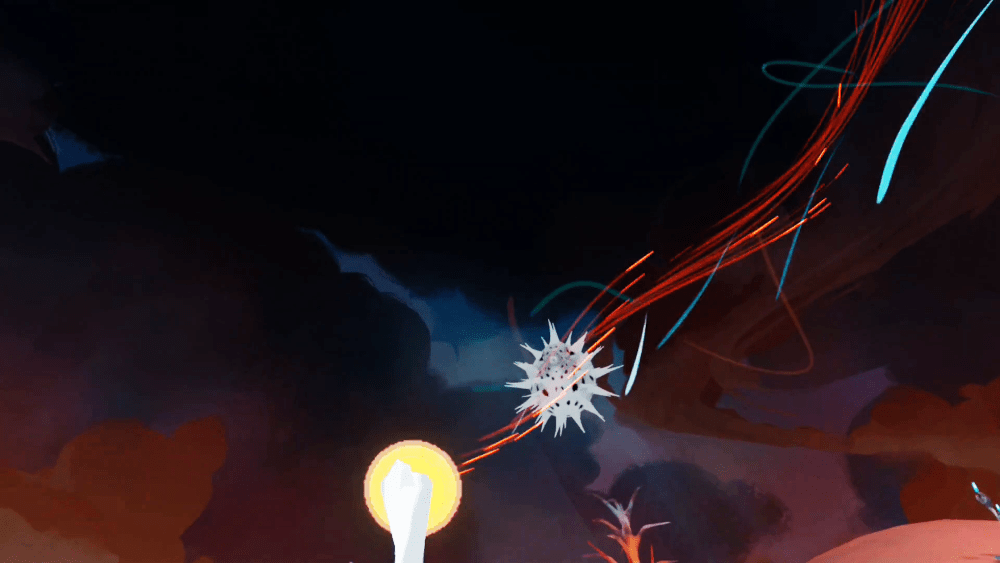FIVARS spoke with J.Dakota Powell, creator of “The Golden Toad.”
What led to the creation of this piece?
A few years ago, the Meta/Oculus Start program ran a game jam for their Start developers in VR. I jumped into the event with the notion of stretching beyond my comfort zone. As opposed to historical realism, the style of the jam piece would be surreal and whimsical. During this short event, what popped out was surprising. Then the format sat on a shelf for a few years. After publishing “M. Curie,” I jumped back into this dreamlike piece as a matter of sheer creative relief. I began the journey with a handful of colorful scenes and some wacky interactions.
What was the production process like for you and your team? What did you learn?
For this particular format, I learned to skirt around self-imposed creative constraints. Think jazz improvisation. Intuitive. Experimental. Spontaneous. I didn’t hesitate to deviate from the storyboard and follow whims. For example, I placed an elephant skeleton in the middle of an oasis. The bones haunted me. I turned the rib cage into a submersible that would descend into an underwater cave. Then I transformed the spine and back half of the ribs into a boat. A long arm bone would serve as a wand. So the production process wasn’t set in stone. I was morphing 3D objects willy-nilly to create “The Golden Toad” environments and props. In this case, the less structure, the better the outcome.
As per the theme, the bones again spoke to me. I started researching the fate of elephants. The African forest elephant is critically endangered due to poaching and loss of habitat. I continued to probe the significant threats to biodiversity. How many species face extinction? Twenty? Fifty? According to the UN, one million plant and animal species are at risk of extinction. It was a wake-up call; I had found my Golden Toad.

How did you become an immersive content creator and why?
Boomerang back to 1995, I was creating interactive formats in Macromedia’s Director and telling stories with HyperCard in NYU’s Interactive Telecommunications Program (ITP). In 1999, I was studying Virtual Reality and Virtual Worlds at ITP and listening to VR pioneer Jaron Lanier describe his data glove.
When virtual reality surfaced its head again in 2015, the timing was ideal. In 1999, I wrote a paper about treating PTSD with VR. In 2015, it was possible to build an application that fulfilled that vision. Immersive technology had taken a critical leap forward.
As per my XR production skills, I enjoy 3D modeling, coding, animation, level design, and concept art, among others. Initially, learning 3D skills was a steep learning curve. Autodesk Maya used to terrify me. Years later, I can jump in and out of ZBrush as if I’m editing a Word doc. At this point, 3D is fun.
What is the AR/VR industry like in your region?
Frankly, I’m more plugged into the XR creator/developer community online than on the ground. I feel as if I have a home base with the Meta/Oculus Start group. If I encounter production issues, which are inevitable given the high volume of XR tech updates (growl), I can always reach out to other Start developers. They’re helpful, highly responsive, and kind.
What do you have planned for the future?
To date, I’m transitioning “Smashers,” a story that revolves around my grandfather, a physicist who worked on the atom bomb (Manhattan Project), from virtual reality to mixed reality. I’ve discovered that the more intimate scenes work well in MR, while scenes with sweeping landscapes are better suited for VR.
One significant difference between the two types of realities is the size of the palette. If MR is theatre, VR is film. That said, I’m ramping up my production in mixed reality. The deeper I dig into the technology, the more I realize that the potential for innovative storytelling is significant.
What would you like to share with fellow content creators and/or the industry?
Keep in mind that we’re still exploring XR as a new medium. Experimentation, going way out on a limb, and pushing beyond trying to create a perfect game or experience, even if it means failing multiple times, are still steps forward. It’s progress.
Given that I come from a long history in the theatre, there’s an old saying: there’s a reason a play is called a “play.” Creators need to play.

Do you think VR festivals like FIVARS are important?
More important than ever. These XR festivals serve as a breeding ground for immersive formats that possess cultural and artistic value. Since FIVARS is an international festival, audiences are exposed to a diverse range of viewpoints and stories. In addition, these XR formats are unique and original. They provide a welcome and necessary balance to a commercial slate of XR games.
“The Golden Toad” is an official selection of FIVARS 2025
Director:














